The Israeli Gal class submarines were based on a modified German HDW Type 206 submarine class (Type 540), with significant differences to make them a class of their own, as they were built in Britain, not in Germany, and took part in the Lebanon crisis notably. Now retired since 2002. INS Gal was laid down in 1974 and launched on 2 December 1975 and became a museum ship since 2007. INS Tanin (ex-Gur) was launched on 25 October 1976, decommissioned in 2002 and scrapped and INS Rahav was launched on 8 May 1977 and decommissioned in 1997 for reasons seen later. They replaced the “T streamline” or British 1936 T class modernized in the 1950 and were replaced in turn by the German-built Dolphin class submarines.
The last British-Built Israeli Subs

The West German Type 206 was an evolution of the Type 205 of 1960, widely seen as the start of the lineage of Cold War German Submarines. The design was constantly improved and modernized through the Type 206 and widely exported, with often tailor-made modifications. It is today with the following Type 209 a proud success of the German industry.
The Type 206 was the successor series started in 1967, of which the first, U13 was laid down in November 1969. They were designed largely in response to the Type 205 constructed of a new non-magnetic steel. These suffered from cracking due to stress corrosion and this needed fixing. Thanks to the advances of German metallurgy at the time, a new high-strength, non-magnetic and austenitic steel was designed. It had greater elasticity and good dynamic strength. It was adopted for construction in the Bundesmarine but failed to attract orders and was not adopted for most export versions.
The Type 206 was designed by Ingenieur Kontor Lübeck (IKL) in 1964–65. After approval in the long German procurement process, the new type was only ordered on 7 June 1969, eight to be built by HDW in Kiel and ten from Nordseewerke, Emden.
18 submarines were built for the Bundesmarine, and 12 were modernized by the early 1990s as Type 206A, and replaced recently by the new Type 212 submarines.
Development of the Israeli version
In 1969, the Israeli Navy was painfully aware of the age of its current fleet, comprising two modernized Tanin class subs (1958) the first stricken in 1968 and the second to the point of being so in 1971, and the three Leviathan class Subs (1967) based on the streamlined T class, called INS Leviathan, Dakar, and Dolphin. They approached the limits of their active life as well, and were due for decommissioning in 1975-77. Dakar was lost in 1968, leaving on the last two active, and Rahav as a school sub.
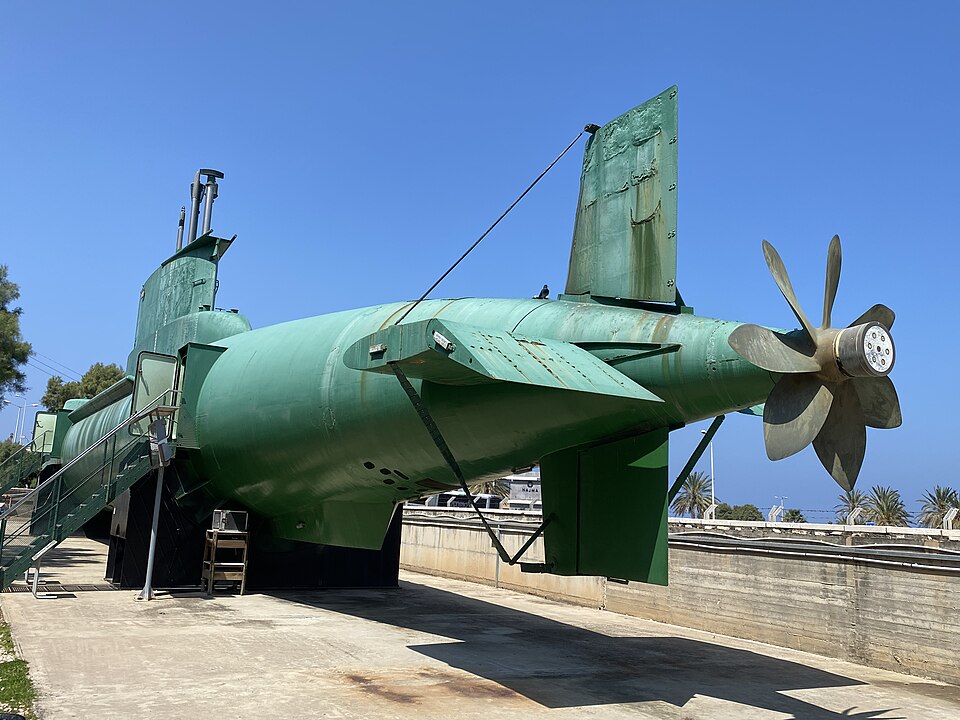
The tail of Gal, a very different design compared to the Type 206.
Despite some political internal opposition, after considering French and British designs, the admiralty turned to the German Type 206 design, made by Howaldtswerke-Deutsche Werft (HDW) as fitting most of its requirements, but with the conditions they would be built in Great Britain. Vickers emerged as a winner for its conditions. In 1975, there was still both in Israel more than in Germany a great unease about the fact of building a warship or weapon system of any type in Germany, for obvious historical and political reasons. An arrangement between HDW was found with Vickers to set up a construction in Britain. There were very strict contractual contingencies as TKMS was very protective of its patterns and industrial know how, as after all, Vickers and TKMS were rivals in submarine construction and export. German experts were sent to Britain for the duration of the project to advise and monitor the whole process.
As a design, the Type 540 as they were known, were a slightly modified variant of the Type 206, with a new distinctive dome forward, changes on the conning tower and other aspects. The German Type 206 design was “interpreted” by Vickers on plans approved s the “Vickers Type 540”, so no relation with the 206 (they could have been named “206I” internally at HDW) and this became its name in IDF ordnance. The class was named “Gal” for its lead ship. Three were built, the first commissioned in 1976. Compared to the ww2 subs in service by then, they were a clear leap forward in technology.
Design
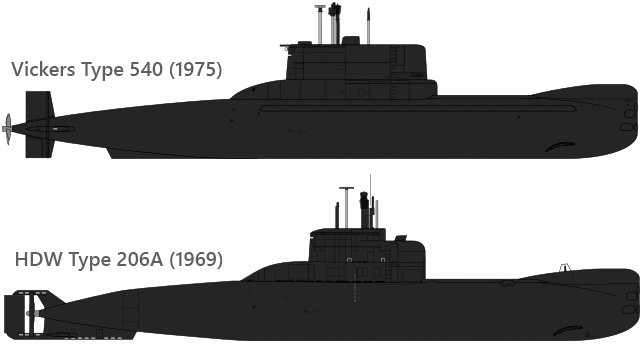
Despite their small size, the Gal class submarines were equipped with the best weapons, observation, listening and electronics of the time, including a radar detector manufactured by Elbit.
The Type 540 submarines were still quite different from the Type 206. They were designed to provide early warning, surveillance and land sabotage or spec ops teams. This was a single compartment design. The CC was right below the conning tower, and most internal accommodations were the same as the Type 206.
What changed most was the sail, much larger and comparable to latter versions of the Type 206, and the tail unit. Instead of a peculiar arrangement with a completely surrounded propeller and rudder at the back, keelson aft on the Type 206, the Gal class had a simpler cross tail and propeller mounted aft of it. The vertical surfaced were strengthened by struts. The keelson was under the aft hull, cut short from the tail. Otherwise, the Type 540 and Type 206 shared the exact same nose, with the sonar dome and four torpedo tubes below, and a pair of curved, retractable dive planes forward. The sail also ended with a typical “hump” connecting to the hull to decrease turbulences, same as the Type 206.
Powerplant
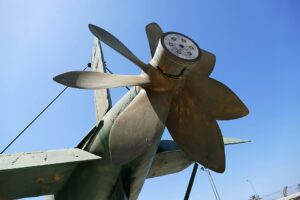 They were powered by two MTU 12V493 TY60 diesel-generators (combined) plus a Siemens 1 electric motor rated respectively for 1,200 and 1,800 hp, making for a surfaced top speed of 11 knots and an underwater top speed of 17 knots. They carried 24 tons of diesel oil for a range of 4,500 nautical miles underwater with snorkel and 200 nautical miles deep underwater at 5 knots. Photo: The peculiar design of the echeloned (almost looked like contra-rotative) 8-bladed propeller of the Gal type for silent operations.
They were powered by two MTU 12V493 TY60 diesel-generators (combined) plus a Siemens 1 electric motor rated respectively for 1,200 and 1,800 hp, making for a surfaced top speed of 11 knots and an underwater top speed of 17 knots. They carried 24 tons of diesel oil for a range of 4,500 nautical miles underwater with snorkel and 200 nautical miles deep underwater at 5 knots. Photo: The peculiar design of the echeloned (almost looked like contra-rotative) 8-bladed propeller of the Gal type for silent operations.
Armament
Torpedoes: Mark 37 and NT37E

Ten torpedoes of the US Mark 37 type were carried at first. Developed by Westinghouse from 1946 this was a new electric type, after WW2 combat experience on the Type 18 proving there were many issues with the design. Entered service in 1957, with the Mod 1 as first variant. Its main advantage was to be very compact (650 kgs., 135 inches or 3.4 meters long), which enabled the storage of ten torpedoes on board the Gal class. Their diameter was inferior to the tubes (19 inches versus 21 inches) so they needed guides inside the tubes. The models adopted were probably the Mod 3 (upgraded from 1967). They had a HBX-3 330 pounds payload with a Mk19 contact exploder. The Mark 37 had Mark 46 silver oxide batteries for 17 knots (31 km/h) or 26 knots (48 km/h) speed settings, and a respective range of 23,000 yards (21 km) at 17 knots or 10,000 yards (9.1 km) at 26 knots. After launch, they used their Gyroscope for their initial run and then their passive sonar when cruising, ending with a Doppler active sonar homing in terminal run to the target.
The NTF37E was the penultimate evolution of the model, adopted by Israel in 1988. But this was an export model from the remaining inventory rebuilt and sold at export including to Israel after their vacuum tube guidance system was replaced by solid-state electronics and a liquid monopropellant for propulsion for better performances and sensitivity.
Sub Harpoon
In 1983 all three Gal class submarines received the capacity to launch the sub-Harpoon SSM (with an estimated UGM-84A on storage if deployed). Israel received these, and they added a long range capability included a Mach 0.9 sped to the target, in pop up attack, carrying a 220 kg warhead at an effective range of 130 km.
Blowpipe SAM
Designed by Shorts Missile Systems Inc. in 1968, powered by an Ejection charge (0.2 s) and cruise engine at 1,626 km/h (1.5 Mach) and 3.5 km range.
The 11 kgs. missile had a launch system weighting 21.3 kg in all, 1.35 m long for a diameter of 76 mm and folded wings, for a wingspan in flight of 274 mm. It carried a 2.2 kg HEAT warhead to the target (likely a helicopter) and was optically guided, detonated by using a proximity fuse.
Sensors
-Plessey Radar: No data
-Plessey Sonar, combined active and passive suite. No data.
-Elbit 4CH(v)1 ECM suite
-Elbit TIOS CCS.

Author’s rendition for “Lebanese Civil War” (Tom Cooper, Efim Sandler) Volume 3 (Helion Publishing, Dec. 2022)
Gal class (Type 540) |
|
| Displacement | 420 tonnes Surfaced/ 600 tonnes Submerged |
| Dimensions | 45 x 4.7 x 3.7 (148 x 15 x 12 ft) |
| Propulsion | 1 shaft 2× MTU diesels 1200 hp, AEG Generators, EM 1800 hp |
| Speed | 11 knots surfaced, 17 knots submerged |
| Armament | 8 × 533mm bow tubes: Sub-Harpoon, NT 37E torpedoes, SAM launcher |
| Sensors | Radar Plessey, Sonar Plessey, Classified EW systems |
| Crew | 32 |
Succession: The Type 209 based Dolphin class

INS Dolphin of the Type 209 at berth in the 2000s.
Modified Type 212 submarines built in Howaldtswerke, Kiel + Thyssen. The class comprised INS Dolphin, Leviathan and Tekuma. IKL Type 800 replacing the Type 500 submarines, authorized in 1988, but project cancelled in 1990. They were originally to be assembled in Ingalls, Pascagoula using prefabricated sections by HDW but in January 1991 the German government offered to built the first two submarines in Germany, with German combat systems. In 1995 the third ordered was reinstated. They were given swimmer lockout facilities in the sail and boat stowage for eight spec-ops.
Torpedo tubes were placed in two horizontal rows, the 650mm tubes outboard. One is usable for swimmer exit and ingress. Liners are used for torpedo launching, and they are enabled the Turbo Popeye nuclear cruise missile, and Triton anti-helicopter missile. Still in service today, alongside the 2012-2020 built Tanin class, built in HDW, Kiel, Germany + Nordseewerke. The latter are also called “Dolphin 2 class”, ordered 2006 and 2012, enlarged and upgraded, but tailored to use Israeli missiles and combat control system. The Israeli fleet as for today thanks to its six Type 212s is probably one of the best in the region.
 INS Gal (1975)
INS Gal (1975)
 Gal (Hebrew for “wave”) was also a common name for both boys and girls in Israel. It was indeed the name of Abraham (Ivan) Dror’s son. He was the 3rd commander of the squadron and head of the project. Gal Dror himself became later an officer on the Gal class submarines. Her trip to Israel from Britain was a potential risk, as shown the loss of Tanin back in the 1960s. Indeed, while underway in December 1976 she was damaged by grounding in her delivery voyage, but repaired.
Gal (Hebrew for “wave”) was also a common name for both boys and girls in Israel. It was indeed the name of Abraham (Ivan) Dror’s son. He was the 3rd commander of the squadron and head of the project. Gal Dror himself became later an officer on the Gal class submarines. Her trip to Israel from Britain was a potential risk, as shown the loss of Tanin back in the 1960s. Indeed, while underway in December 1976 she was damaged by grounding in her delivery voyage, but repaired.
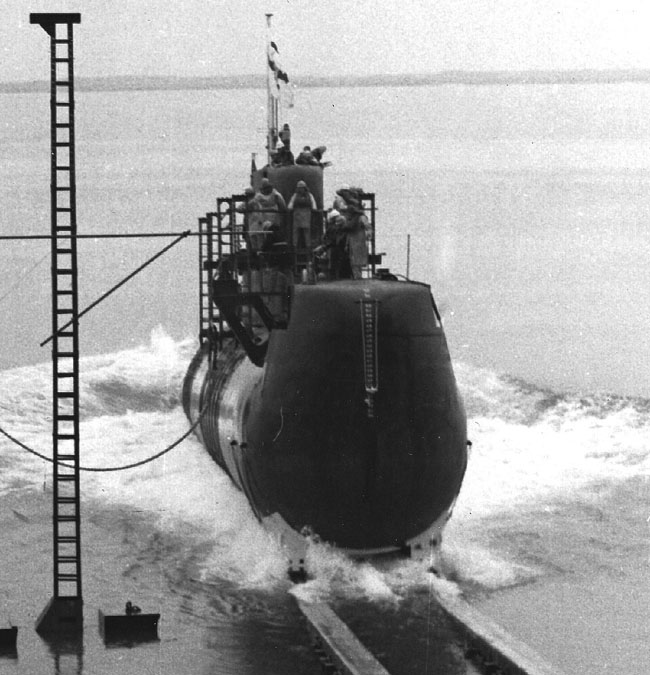
Launch of Gal in Britain, 1975
Gal entered service under command of Israel Leshem, 5th squadron commander and was assigned to the Haifa base on December 1976. Commander Doron Amir received command of the squadron shortly before the arrival of Rahav and this became a first for the Israeli navy to have three 3 modern submarines freshly commissioned operating in concert. The Gal class started to familiarize themselves with the northern border especially when the political situation started to heat up, with a battle against the PLO and other terrorists groups based in Lebanon just ramping up every day.
Soon, like her sisters, Gal was deeply involved in Israel’s war in Lebanon. Most of their operations remained top secret, but their contribution remained important and essential.
She took an important part in the 1982 Lebanon war, showing with her sister that project head Ivan Dror and his team wrote the right specifications and chose the right design for them. These were small, agile, highly manoeuvrable, with a small, cost-effective crew, still highly skilled to all sorts of operations. All their operations proved they were the right submarine for Israel.
In 1983 all three boats received the Sub-Harpoon and its associated fire-control equipment with US help. Once installed, it procured an amazing new long range offensive capability against any surface asset of Israel’s enemies. This also came with the new NT 37E torpedoes, replacing the older Mk 37 models in service from 1987-88. Gal and her sisters were also extensively overhauled in 1994-95, and this included an upgrade of all their onboard sensors and fire control system, into the digital age, computers started to appear in the CC.
Again all details on operations remained unclassified, but suffice to day these submarines were used in ways and in frequency that no other submarine in the world at the time performed. The proximity of the theatre of operation also helped to accelerate their rotations, with efficient maintenance in between to shorten their inactive time. However in the 1990s, the necessity for a more modern submarine force was proven true every day, and the new programme, called “Dolphin” started around 1982 already. They were very likely used to infiltrate anti-terrorist IDF spec Ops agents by night as main purpose, and by day patrolled for weapons smuggling among others.
Passing the cape of the Cold War and into the 1999-2000 threshold, the Gal class submarines were now 20 years old, with core design that went all the way back to 1965. with the 3 modern Dolphin class submarine entering service, the Gals remain operational as long as possible, thus, until 1997 for Rahav (see below) and until 2002 for the two others. Less active in their final years, they were used as training boats for the Dolphin crews.
When the Israeli navy received its new Dolphin-class submarines (also built by HDW), the Gal class boats were retired and kept there, their property returned to HDW which attempted to find a buyer for them. But when none was found, two were scrapped and Gam was returned to Israel, for display in the Clandestine Immigration and Naval Museum of Haifa.
 INS Tanin (1976)
INS Tanin (1976)
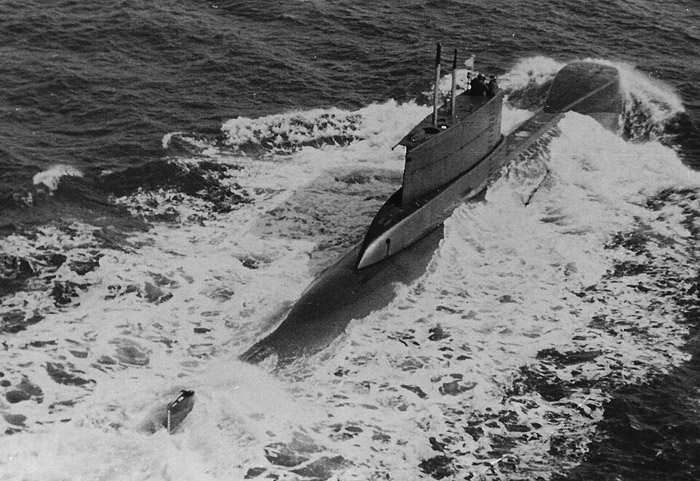
IS Tanin underway to Israel in 1977
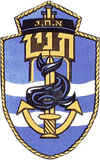 INS Tanin, under the command of lieutenant commander Doron Amir arrived in Haifa by July 1977.
INS Tanin, under the command of lieutenant commander Doron Amir arrived in Haifa by July 1977.
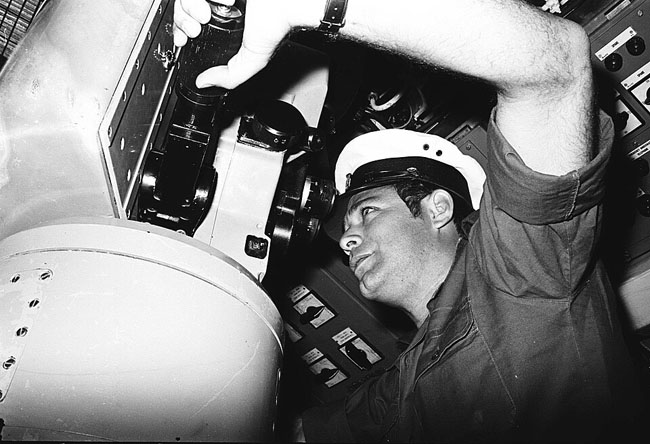
Admiram Einat, 1sy commander of IS Tanin
Tanin took part in Operation Peace for the Galilee, and most details remained classified to this day.
Tanin and Gal were transported after a period of storage in the port of Haifa, and from there, towed on a barge up to a shipyard in Germany where they awaited a buyer. In 2007, after no buyers were found for these outdated models, Gal was renovated by the German shipyard and turned into a museum submarine. With German funding, she was transferred back to the Immigration and Navy Museum in Haifa, returning to Israel on October 7, 2007, was transported on a special heavy duty truck to the museum.
 INS Rahav (1977)
INS Rahav (1977)

INS Rahav with Amiram Einat as her skipper joined the flotilla a year later, on December 1977. She was part of the same unit, the 11th flotilla, and took part in the same operations as her two sisters in the Lebanon war. Rahav was decommissioned in 1997 and scrapped but the initial reason is unclear. One of these submarines, possibly Rahav, was implicated in a scandal, as it sank a Lebanese refugee boat after an identification error. There was a cover-up, and Col. (Ret) Mike Eldar, who commanded the 11th flotilla during the war, said the captain acted improperly and accused Israel of trying to cover up the incident. The IDF only investigated the incident 10 years after it occurred. There was documentary by Channel 10 in 2018 about the event.
Tanin and her sister Rahav were named after Biblical sea monsters: They were mentioned in Isaiah 51:9:
“Awake, awake, put on strength, O arm of the Lord; awake as in the ancient days, In the generation of old! Art thou not it that hath cut Rahab (Rahav), and wounded the dragon? (in Hebrew, Tanin)”
These names also was earned by the next two boats of the Dolphin class.
Read More/Src
Gallery:
Books:
Yoram Bar-Yam, Israeli Vessels in the Fourth Dimension, Dolphin Association
Zeev Almog, Commander of Fleet 13 – My Life’s Voyages, Kinneret, Zmora Bitan, 2014, pp. 1034-1044
Michael Eldar, “Dakkar and the Story of the Submarine Fleet”, Aryeh Nir Publishing, Modan. 1997
Lebanese Civil War Volume 3
Sites:
on web.archive.org/ submarines.dotan.net/gal/
globalsecurity.org/ gal.htm
navypedia.org gal.htm
web.archive.org submarines.dotan.net/
submarines.dotan.net/gallery/
dolphin.org.il/
commons.wikimedia.org/ Interior_of_INS_Gal
he.wikipedia.org/ gal class
timesofisrael.com 1982 sinking
On the blowpipe SAM system






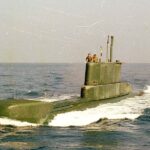
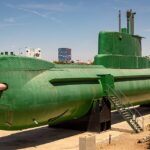
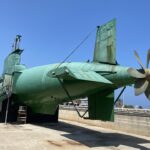
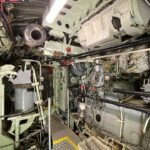

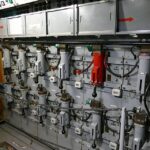
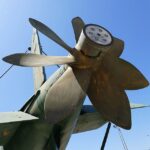


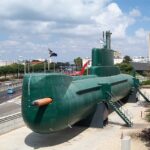
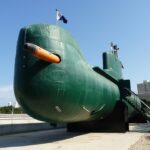
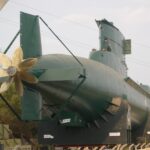
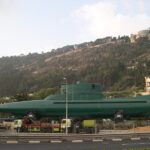
 Latest Facebook Entry -
Latest Facebook Entry -  X(Tweeter) Naval Encyclopedia's deck archive
X(Tweeter) Naval Encyclopedia's deck archive Instagram (@navalencyc)
Instagram (@navalencyc)


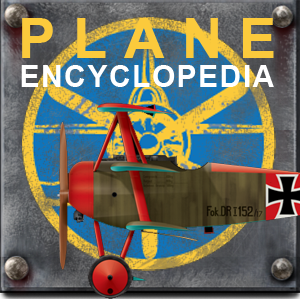
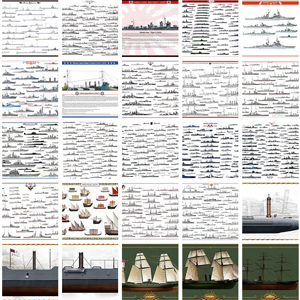

 French Navy
French Navy Royal Navy
Royal Navy Russian Navy
Russian Navy Armada Espanola
Armada Espanola Austrian Navy
Austrian Navy K.u.K. Kriegsmarine
K.u.K. Kriegsmarine Dansk Marine
Dansk Marine Nautiko Hellenon
Nautiko Hellenon Koninklije Marine 1870
Koninklije Marine 1870 Marinha do Brasil
Marinha do Brasil Osmanlı Donanması
Osmanlı Donanması Marina Do Peru
Marina Do Peru Marinha do Portugal
Marinha do Portugal Regia Marina 1870
Regia Marina 1870 Nihhon Kaigun 1870
Nihhon Kaigun 1870 Preußische Marine 1870
Preußische Marine 1870 Russkiy Flot 1870
Russkiy Flot 1870 Svenska marinen
Svenska marinen Søværnet
Søværnet Union Navy
Union Navy Confederate Navy
Confederate Navy Armada de Argentina
Armada de Argentina Imperial Chinese Navy
Imperial Chinese Navy Marinha do Portugal
Marinha do Portugal Mexico
Mexico Kaiserliche Marine
Kaiserliche Marine 1898 US Navy
1898 US Navy Sovietskiy Flot
Sovietskiy Flot Royal Canadian Navy
Royal Canadian Navy Royal Australian Navy
Royal Australian Navy RNZN Fleet
RNZN Fleet Chinese Navy 1937
Chinese Navy 1937 Kriegsmarine
Kriegsmarine Chilean Navy
Chilean Navy Danish Navy
Danish Navy Finnish Navy
Finnish Navy Hellenic Navy
Hellenic Navy Polish Navy
Polish Navy Romanian Navy
Romanian Navy Turkish Navy
Turkish Navy Royal Yugoslav Navy
Royal Yugoslav Navy Royal Thai Navy
Royal Thai Navy Minor Navies
Minor Navies Albania
Albania Austria
Austria Belgium
Belgium Columbia
Columbia Costa Rica
Costa Rica Cuba
Cuba Czechoslovakia
Czechoslovakia Dominican Republic
Dominican Republic Haiti
Haiti Hungary
Hungary Honduras
Honduras Estonia
Estonia Iceland
Iceland Eire
Eire Equador
Equador Iran
Iran Iraq
Iraq Latvia
Latvia Liberia
Liberia Lithuania
Lithuania Mandchukuo
Mandchukuo Morocco
Morocco Nicaragua
Nicaragua Persia
Persia San Salvador
San Salvador Sarawak
Sarawak Uruguay
Uruguay Venezuela
Venezuela Zanzibar
Zanzibar Warsaw Pact Navies
Warsaw Pact Navies Bulgaria
Bulgaria Hungary
Hungary

 Bundesmarine
Bundesmarine Dutch Navy
Dutch Navy Hellenic Navy
Hellenic Navy Marina Militare
Marina Militare Yugoslav Navy
Yugoslav Navy Chinese Navy
Chinese Navy Indian Navy
Indian Navy Indonesian Navy
Indonesian Navy JMSDF
JMSDF North Korean Navy
North Korean Navy Pakistani Navy
Pakistani Navy Philippines Navy
Philippines Navy ROKN
ROKN Rep. of Singapore Navy
Rep. of Singapore Navy Taiwanese Navy
Taiwanese Navy IDF Navy
IDF Navy Saudi Navy
Saudi Navy Royal New Zealand Navy
Royal New Zealand Navy Egyptian Navy
Egyptian Navy South African Navy
South African Navy






























 Ukrainian Navy
Ukrainian Navy dbodesign
dbodesign